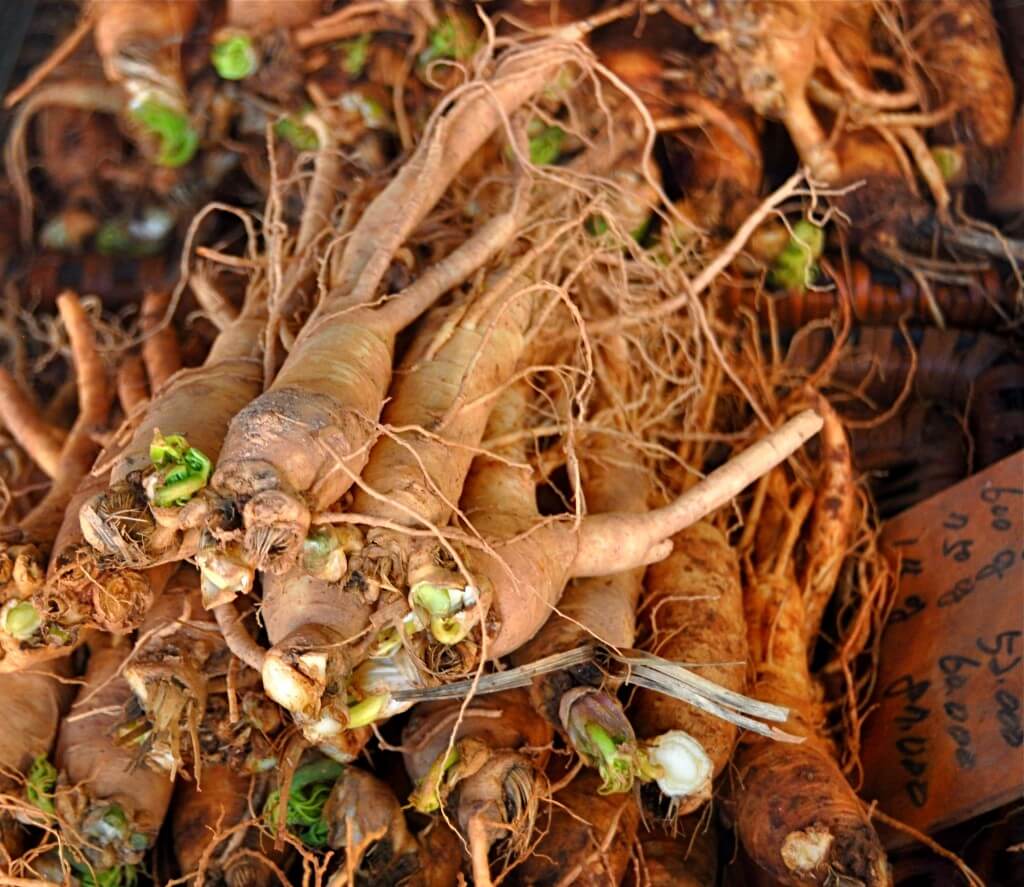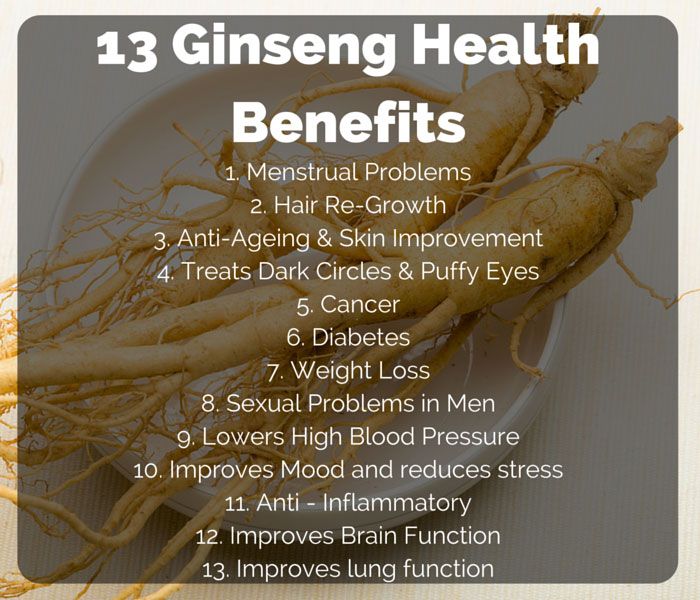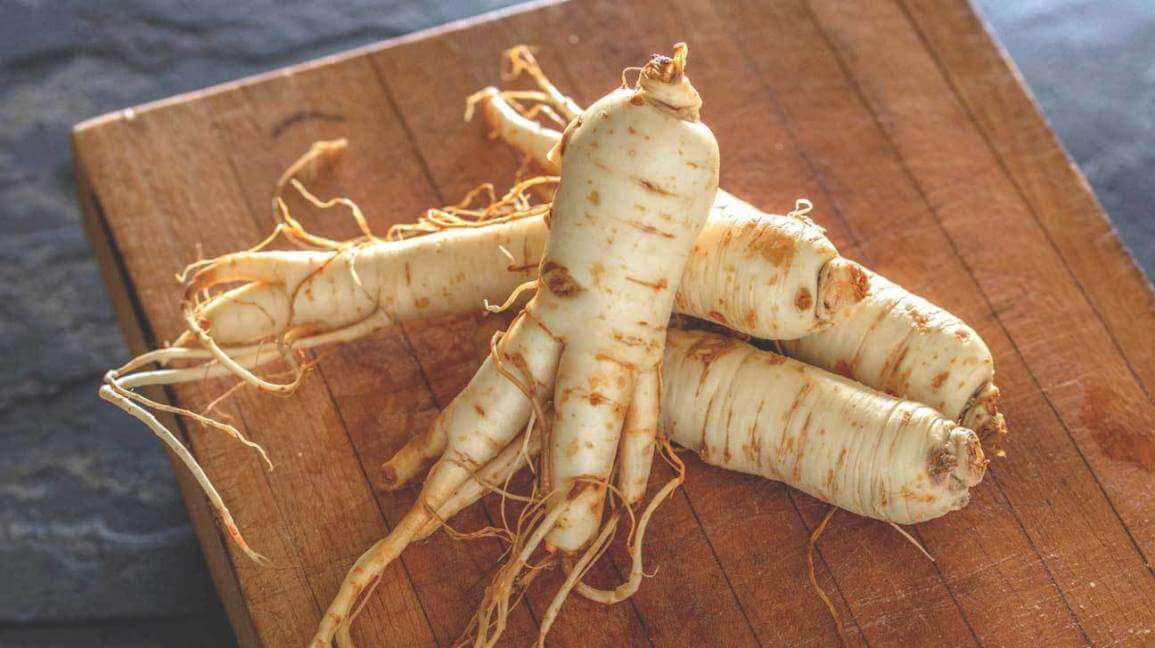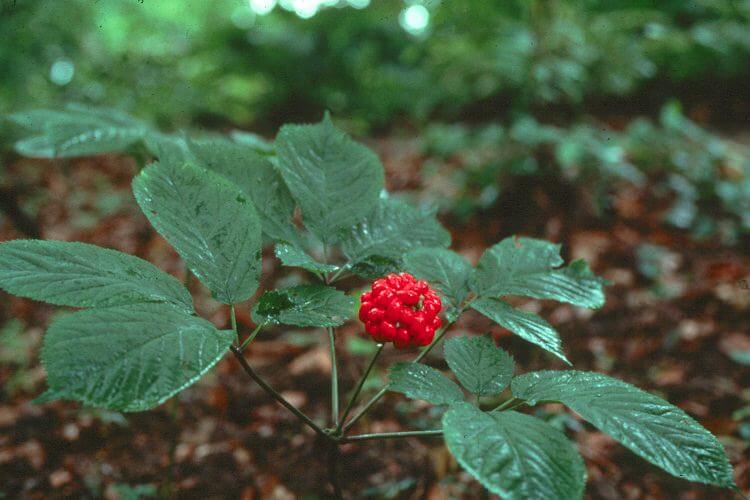Ginseng is a plant with fleshy roots, used in traditional Chinese medicine for centuries.
The word “Ginseng” means Man-root because the flesh roots’ shape resembles a man’s legs.
It helps in reducing blood sugar levels, cholesterol levels, reduces stress, and treats diabetes. It also relaxes the body and boosts energy.
Depending on its stage of growth, Ginseng is of three types:
- Fresh
- White
- Red
Fresh Ginseng is harvested within four years. White Ginseng is harvested between 4-6 years, and Red Ginseng is harvested after at least six years of growth.
Two variants of this dwarf, slow-growing plant are prevalent and most used – American Ginseng and Asian Ginseng.
American Ginseng v/s Asian Ginseng

American and Asian Ginseng are different due to their concentration of active compounds and effects on the human mind and body.
American Ginseng helps relax the body while Asian Ginseng revitalizes and rejuvenates the body (Just like Red Bull!!)
Ginsenosides and Gintonin are two compounds in Ginseng that work together to help you feel relaxed and fresh even after staying awake for 24 hours!!
Can Your Grow Ginseng in Your Home?
Unlike other plants, Ginseng is not very easy to grow. It takes at least four years to grow, and on top of that, you need the perfect conditions for the growth of this Aphrodisiac.
It would help if you had a perfect environment, best quality seeds, supplies and tools, ample space, and lots of patience. You cannot hope to yield a great harvest in 3 months or even a season. Thankfully, once you plant the seed, the plant takes care of its growth given the right conditions required.
Steps are as follows:
- Create a perfect environment for growing Ginseng.
- Preparing the seeds: Stratification, Keep the stratified seeds moist and refrigerated in a plastic bag before planting. Place the stratified seeds in 1/10th cup of bleach with water to kill the fungus or other infections the seed may carry.
- Plant the stratified seeds for sprouting.
- Plant the seeds leaving 3 inches of space between 2 seeds.
- Research well about pesticides and insecticides well suited for Ginseng. Spray it on the crop occasionally to avoid an infected crop.
- Wait for the plant to mature over the years.
- While harvesting, preferably in the fall season, dig carefully to avoid damaging the roots.
If you are growing Ginseng on land, cover the planted seeds with layers of mulch leaves, this keeps the ground moist, which is a vital requirement for growing Ginseng.
Disclaimer: Do not use mulch oak leaves. They are too harsh and broad for the sprouted Ginseng seeds to grow through. Shred them first if you already have oak leaves available.
Environment: Ginseng requires a warm and moist environment to grow. So, if you live in a climate, you might want to consider installing a greenhouse in your lawn or building a room with a regulated temperature inside your house for successful sprouting and growing.
Seeds: It is relatively easy to get the Ginseng seedlings from an online or a bricks and mortar store. The problem comes when people plant them in midsummer, expecting them to grow, which will not happen.
For Ginseng plants, their seeds go through the process of stratification. It is a process in which the seeds lose the flesh of the berries and prepare to sprout. The seeds go through this process for about a year, after which they sprout.
Initially, the seedlings need to be in a frigid environment until they start to germinate and grow. Remember to plant the seeds 3 inches apart from each other for enough space for the plants to grow.
Soil: Before popping the seeds into the soil, make sure to test the soil’s pH levels (amount of acid or base). According to some experiments, though it is not 100% proven yet, the soil’s adequate pH balance is supposed to be from 4 to 7.
*Make sure to test the soil once every year, at least*
Fertilize the soil only when required. The pH levels can be increased (towards essential nature) by adding lime (calcium carbonate). But you want to add gypsum (calcium sulphate).
Ways to Consume
When the plant’s maturity has reached and the root is harvested, you all can consume the root raw or used fresh in tea, in soups, and stir-fried.
Health Benefits

Antioxidant & Anti-Inflammatory
It has been scientifically tested and proven that the two compounds of Ginseng – Ginsenoside and Gintonin reduce inflammation by targeting pathways in the immune system and generate antioxidant qualities in the body’s cells.
Treating Erectile Dysfunction
A Korean study in 2002 proved that Red Ginseng is successful in improving the symptoms of Erectile Dysfunction and enhancing sexual behavior. Ginseng has been a popular aphrodisiac also known to improve sperm quality and sperm count for healthy and patients dealing with infertility.
Benefits of Brain Function
Ginseng helps to improve memory, behavior, and mood.
The compounds in Ginseng – Ginsenosides and Compound K help in protecting the brain against free radicals.
As a part of a scientific study, 30 healthy people consumed 200mg of Panax Ginseng regularly for four weeks. At the end of the experiment, they showed drastic improvement in mood, social functioning, mental ability, and mental health.
Increases Energy
Ginseng helps to stimulate mental and physical activities in people who are chronically weak and exhausted. Ginseng has shown results in helping patients undergoing treatment for cancer with chronic fatigue.
Helps in Preventing Flu
Research suggests a possible connection between Ginseng and the treatment and prevention of Influenza and Respiratory Syncytial Virus (RSV). Not practically 100% successful, but it is said that red ginseng extract can improve the survival of human lung epithelial cells infected with the Influenza Virus. Ginseng is also known to strengthen the immunity system.
Reducing Blood Sugar Levels
Several studies suggest that Ginseng helps in lowering blood sugar levels and helps in treating diabetes. Ginsenosides affect the production of insulin in the pancreas and improve in resisting insulin using other mechanisms.
Benefits Against Cancer
As said before, the compound, Ginsenosides, and Gentamicin help reduce inflammation and help in the body’s antioxidation.
The process of growth and division of cells is called the cell cycle. Ginsenosides benefit this cycle by preventing abnormal cell growth and production.
After research and further observational studies, it is seen that people taking a regular dosage of Ginseng are less likely to develop the following cancers than those who do not take a regular dosage.
- Lip cancer
- Mouth cancer
- Esophagus cancer
- Stomach cancer
- Colon cancer
- Liver cancer
- Lung cancer
Ginseng also improves the health of cancer patients undergoing Chemotherapy and face fatigue. It helps by reducing the side effects of Chemo and enhances the effect of the treatment drugs.
Although, this is still a debatable issue, as research is still going on about Ginseng helping with Cancer and the Effects of Chemotherapy.
Easy to Add to your Daily Routine.
Ginseng can be consumed in different ways; it can be eaten raw or steam for some minutes to soften it. It can also be stewed in water to make Ginseng Tea. You must add hot water to freshly sliced Ginseng and let it blend and steep for a few minutes.
Consumption

Consumption depends on the illness you want to improve. In general, daily doses of 1-2 grams of raw root of Ginseng or 200-400 mg of Ginseng extract is usually advised.
Side Effects
Natural does not always mean safe. If taken over six months, consumption of Ginseng can cause –
- Insomnia
- Menstrual Problems
- Breast Pain
- Itching
- Diarrhea
- Mood Swings
- Vaginal Bleeding
- Rash, dizziness, headaches
- Low blood pressure and loss of appetite.
- And other allergic reactions.
Avoid mixing other medications with Ginseng. Unsafe for pregnant women, infants, children, patients with diabetes, and heart problems. It is unsafe for patients with bleeding issues to use Ginseng as it interferes with Blood Clotting.
Legalities
Before practically growing Ginseng and selling it to the masses, do look at the legalities involved. Ginseng is illegal to sell if you are not a licensed grower of the herb.
Make sure you have a dealer’s license.
Also, every state has different regulations regarding licensing. Please check first. You will need to fill out an application and pay a fee.
For selling on an online platform, you still need an export license.
Growing Ginseng is legal for private consumption and not being sold in the market. But as with every state, the country has different rules and regulations, although you should still check with the officials before growing, as an infringement of law will lead to hefty fines and probably jail.

